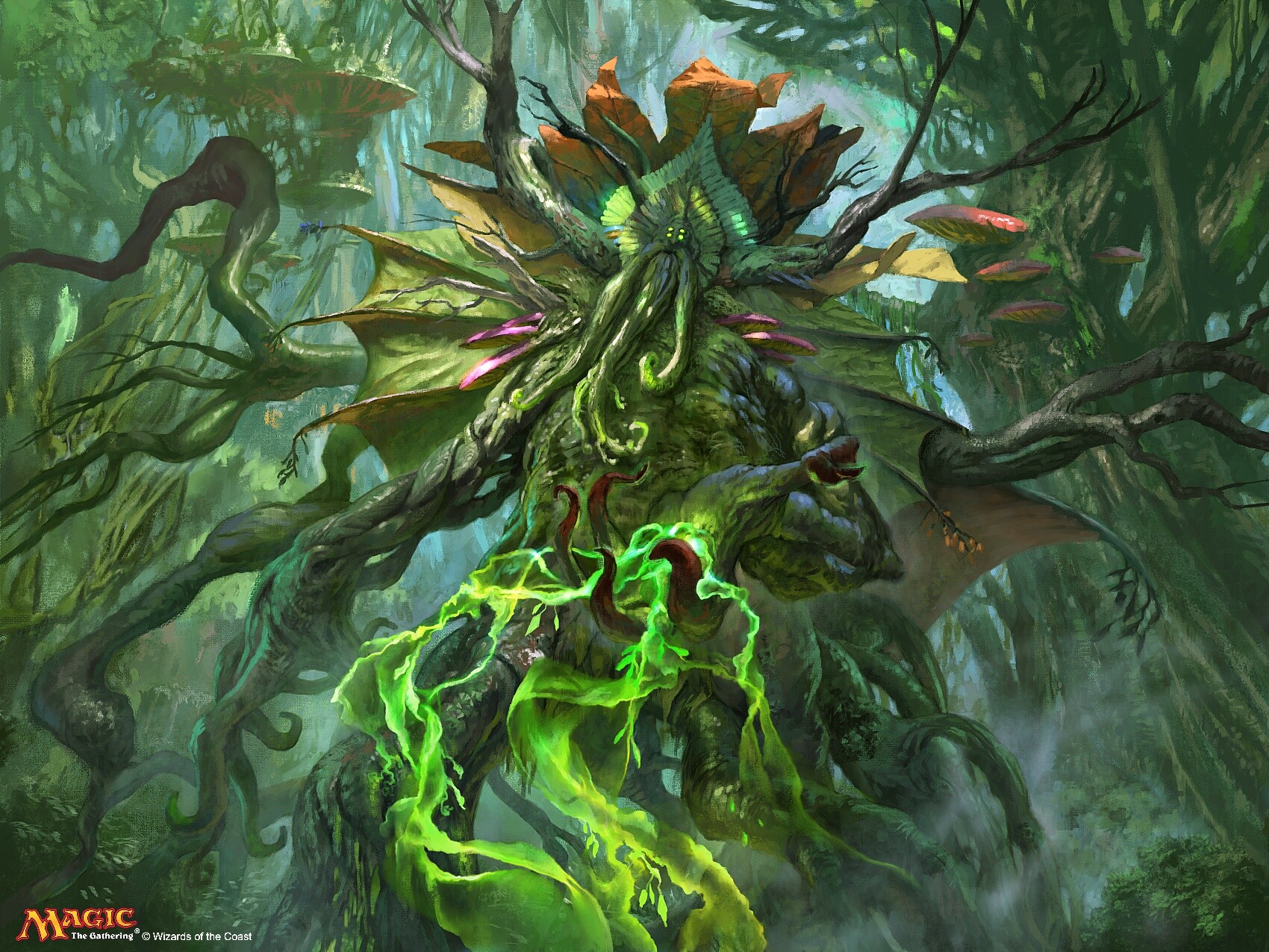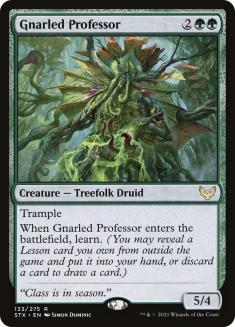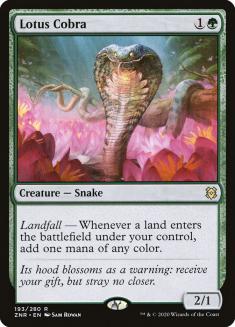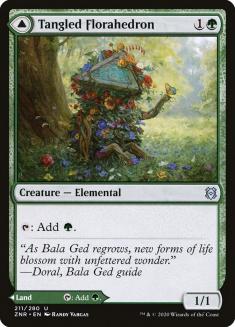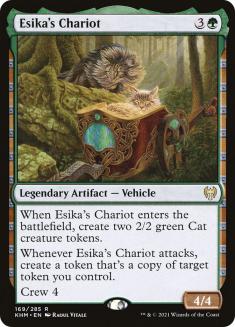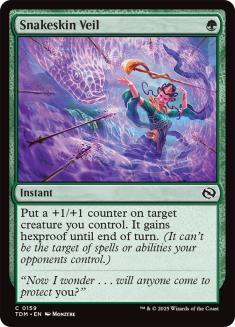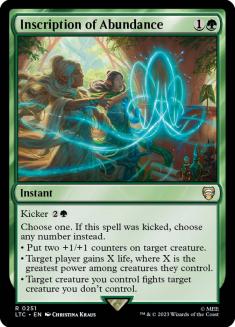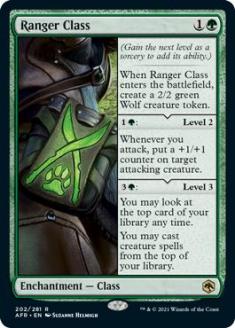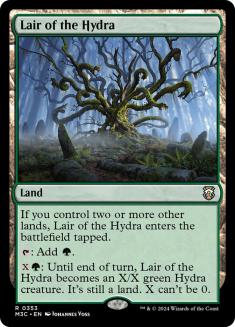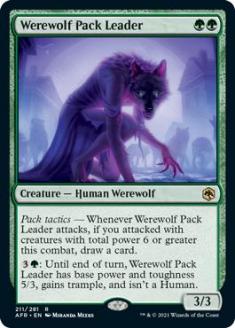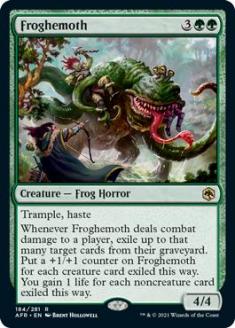The current Standard featuring Throne of Eldraine is a lame-duck format. Too many powerful cards are stifling the lower-powered (but fun) stuff that’s been made in 2021 and everyone knows it. Even Wizards of the Coast (WotC) knows it, which is why they’ve made Standard 2022 on Magic Arena. Multiple organizations and streamers have been running Best-of-Three events on MTGMelee, including one where Brad Nelson took first place.
Not only does rotating out the majority of 2020 cards breathe new life into existing game pieces, but we actually get to see what these new cards from Adventures in the Forgotten Realms can do. I have no love for Throne of Eldraine or the companion mechanic, so exploring this new format before it fully develops later this year is not only useful, it’s incredibly fun.
We had a small glimpse of what a more aggressively rotating format could look like a few years ago, but WotC deemed it a failure because too many people complained about their cards cycling out of Standard too quickly. That same complaint might happen here too, but WotC has at least done the smart thing and let Traditional Standard queues still exist, with ladder progression counting on all manner of different formats being played.
Standard 2022 seems robust so far. Today’s article, and multiple articles from my fellow writers this week, explore that format. I will be primarily focused on Mono-Green Aggro with an emphasis on the new cards that make the archetype tick, as well as some old hits that were mostly overshadowed until now. Let’s get started and figure out what this new Standard 2022 format is all about!
Let me be clear that I will be focusing on Best-of-Three, which doesn’t currently have a queue on Magic Arena. Instead, I assume most organizers for larger tournaments on MTGMelee will be using Standard 2022 Best-of-Three, and WotC will shortly add that option to Arena ladder progression.
Mono-Green in Every Format
The key to a successful format is to offer a variety of gameplay experiences. Not everyone has to like everything, but covering a large base of customer demographics helps sell more cards and create more diverse experiences in games and tournaments. No one wants to face the same three cards or decks every round, so it’s imporant for the game designers to keep those cards and archetypes balanced so they don’t overshadow everything else. That aspect is one of the things that draws people to Modern, and historically what as been used to dub a Standard format as great.
Diversity in card selection is about the same in priority as diversity in gameplay. You want a wide range of archetypes to have varying play patterns so that games aren’t always Rock VS Paper VS Scissors. Archetypes should have variable card choices based on an expected metagame. Sideboards should contain tools that strike a large number of metrics and can contain problems that might otherwise arise. Standard has seen green be a key player over the last few years, with Nissa, Who Shakes the World being an emphasis. Today’s green decks look a little different, with a lot less ramp and a lot more “kickin’ your ass.”
Creatures (32)
- 4 Lotus Cobra
- 4 Swarm Shambler
- 4 Tangled Florahedron
- 4 Kazandu Mammoth
- 4 Old-Growth Troll
- 4 Gnarled Professor
- 4 Werewolf Pack Leader
- 4 Froghemoth
Lands (16)
Spells (12)

The most recent Insight Esports Standard 2022 event was won by this decklist. It bested 64 other players in an event that you had to qualify for. It went undefeated through the Swiss and ultimately took down the tournament without a scratch. So what makes this version better than all the others? Let’s examine how Sam Beaulieu built his deck for this event and what made it stand out among the rest of the field.
The Old
The learn mechanic hasn’t gotten much love, but I always felt like it might be good enough given a lower power level in a format. After all, learn is just a way to draw cards without actually saying “draw a card.” Each Lesson is worth close to a spell, and they get a lot better as more more mana pumped into them. Specifically, Mascot Exhibition is a fine Magic card and an easy pickup for learn once you have enough mana.
The trick is making sure you can get some value out of those other Lessons when you aren’t quite there yet. Our sideboard contains a wide variety of spells to get in a number of situations. You can read them. They’re pretty simple and do something pretty specific most of the time. Basic Conjuration is my least favorite, but I definitely understand why it’s there. I just think it’s not worth the investment most of the time.
Gnarled Professor on the front side is actually a very hefty body. A 5/4 trample for four mana with only upside is pretty outrageous, and replacing itself makes it one of the better choices for plays when you hit your fourth mana source. Off an early Tangled Florahedron or Lotus Cobra, it coming down on the third turn could be disastrous for the opponent, as it provides you with a stiff threat and an extra card to play on the following turn. It helps offset mulligans, and trades nicely in an attrition battle. It’s just an all around excellent card that only asks for a few sideboard slots. How many you want to dedicate to it is up to you.
Few decks in Standard 2022 can keep up with Mono-Green Aggro because the mana acceleration is so fluid. Instead of playing a ton of creatures like Jaspera Sentinel, the deck is focusing on cards that offer unique play patterns. When things are going very right, the ramp effect of these cards give the ability to burst onto the scene, attacking the opponent before they can get the shields up. When things are going poorly, or you’re missing land drops, using Tangled Florahedron as a land is more than good enough.
Lotus Cobra is aggressively built as far as power is concerned. Not only does it allow you to ramp, but it doesn’t actually tap the Lotus Cobra itself. It obviously would work better with Fabled Passage and the like to generate extra bumps of mana, but we’re not too worried about hitting six or seven mana in the early turns. We just want a curve, and this little Snake gives it to us while attacking in the meanwhile. Lotus Cobra playing the part of aggro two-drop while also providing a mana jump here and there is clutch.
Esika’s Chariot has impressed me in a few different formats in a variety of shells. It’s such a hefty amount of power and toughness for such a small investment, and is self-sustaining when it comes to making more pressure and crewing the vehicle. As far as Vehicles go, it is one of the best all time, and continues to be a major player in any green deck that wants a lot of power or tokens.
One thing I discounted off the bat with Esika’s Chariot is that it made tokens for you to copy. I was so obsessed with finding ways to make cool tokens to copy, but just making more Cats is more than fine, and will ultimately be what you do with it in this shell (outside of attacking and blocking, of course). Army-in-a-can creatures have always been something to look for when building straightforward aggro decks, because they allow you to apply pressure to the battlefield without a major investment of resources. Sweeper effects like Shadows’ Verdict can take a serious toll on our threat development, so having a permanent that dodges that removal or is a great follow up to that removal is sick.
Targeted removal sees a lot of play in Standard, and Standard 2022 is no exception. Dimir Control looks to counter and kill all your stuff, and Snakeskin Veil can help with roughly half of that problem. I’ve been a proponent of cards like Blossoming Defense in the past and Snakeskin Veil falls in that category perfectly. It’s much better than I originally thought and continues to impress basically every time I see it in action.
One thing to note is that the extra +1/+1 counter buff is permanent. Unlike Blossoming Defense, if some start rotting in your hand, you can just purge them and put a few counters on your creatures. Doing so allows for them to gain some value in matchups where your opponent isn’t exactly targeting your creatures too much. The added benefit of using it as a combat trick when your opponent goes to block makes it viable in a good percentage of matchups. Spells like Snakeskin Veil and Blossoming Defense don’t come along often, but I usually seek out the decks that play them because I know how powerful that type of effect can be in a Standard-ish format.
Depending on how the format shakes out with the Innistrad: Midnight Hunt, Blizzard Brawl could be a fine replacement. We don’t have much interaction, and Blizzard Brawl with some snow lands and maybe Faceless Haven could be a nice option. A few builds are running that right now over Snakeskin Veil, but Blizzard Brawl is much worse against the control decks running around. It’s more of a judgment call than anything else.
I’ve seen plenty of versions play Inscription of Abundance maindeck, so I’m confident it’s powerful enough to find a home in the right builds. However, this version is a lot less interactive than other ones I’ve seen, instead focusing on protecting its own creatures and not worrying too much about killing your opponent’s. Because combat is so easy to navigate with all our buffs and tricks, and our creatures grow so large without much help or trouble, filling our deck with interactive elements is less important than filling it with good threats and protection. Think of this deck like Infect more than a traditional Mono-Green Aggro deck.
If we need to get more interactive after sideboard, Inscription of Abundance is a jam. It’s so versatile in how it plays out while also giving you a pretty big boost when you hit five mana. I’ve loved Dromoka’s Command in the past for archetypes like this. This card is a little more expensive to get the Dromoka’s Command experience, but similar enough that the comparisons make sense. You can do a lot worse than “more expensive Dromoka’s Command” that only requires one color.
The New
Ranger Class getting some love is no surprise. It’s one of the few Class cards that generate some sort of immediate pressure when cast. The second level also generates some pressure and makes it incredibly difficult to predict how combat will go when your opponent starts sequencing for their own turn. Since you gain that extra +1/+1 counter every combat, you can make life difficult for your opponent if their plan is to play defensively with creatures.
Boosting some of your smaller threats and turning them into bigger bodies is also important when your opponent has sweepers or is removal heavy. It’s a great topdeck, as it allows you to pour all your excess mana into it. Level 3 allows you to cast creatures from the top of your deck, which is perfect for anyone who is flooding out. Giving you a way to use that extra mana from Lotus Cobra and Tangled Florahedron is also a plus.
Most aggro decks tend to thrive when they have mana sinks. It’s been nice to see Faceless Haven be a huge part of the format, but I’m more excited to see what cards like Ranger Class and Lair of the Hydra can do. Lair of the Hydra has been exceptional in my testing so far. Having a way to dump all your extra mana into your threats is so cool, and it doesn’t suffer from the usual downfall of creature-lands in your aggro deck entering the battlefield tapped in the early turns. Of course, our deck goes a little bigger than traditional aggro, which means it entering the battlefield tapped on a later turn could be devastating, but I’m a huge fan of variable gameplay and these powerful lands need some type of drawback. It’s just the reverse of what we usually see.
All of the creature-lands in this set look damn good, but the ones that don’t cost much mana to activate are useful in aggro decks, which tend to need untapped lands early. Lair of the Hydra doesn’t cost much to activate if you want to chip in some damage, but the threat of it hitting hard in the later turns can’t be ignored. If your opponent is reliant on sorcery-speed removal, Lair of the Hydra will eat them alive.
Pack tactics are much easier to turn on in green than any other color because your creatures are naturally larger on average for the casting cost. Turning on that ability with Werewolf Pack Leader isn’t difficult at all, usually when you attack with just one other creature besides it. Drawing a card every time you attack is pretty cool, right?
The body for just two mana is stout and it’s hard to ask for better. You also have a mana sink which can provide more pressure later in the game, but I don’t plan on using that one too much. I like that this card doesn’t care much about tribal synergy, and is cheap enough to provide you with real pressure against control.
Froghemoth is one of the new cards from Adventures in the Forgotten Realms that gives us a nice top-end beater that has some neat interactions with the opposing graveyard. If your opponent is graveyard-centric, exiling things could be very useful. If not, you can just grow the Froghemoth. Against an aggressive opponent attacking your life total, gaining a few points of life can save the day in a racing scenario. For five mana, you need to be getting a pretty big payoff. With haste and trample, a growing body, and the ability to constantly interact with the graveyard, I’d say that Froghemoth does it all.
Without Questing Beast running around, we need some heavy hitters on the top of the curve. The haste and trample of Froghemoth will steal some games you might have no business of winning. I could have already seen it in action, so I know exactly what it can do. The aspect of having it continuously grow means it usually gets out of control and will quickly become impossible to kill inside combat.
Standard 2022 and Beyond
With the very positive reception of Standard 2022, there’s a chance that rotations start happening on a more frequent basis. All we want is to play Magic with cool new cards and experience the game as the card designers intended. It’s clear that Adventures in the Forgotten Realms is at a much lower power level than Throne of Eldraine, and I’m glad to see it move in that direction. Seeing all these new Standard 2022 decks leads me to believe that so many different cards and archetypes can thrive as long as there isn’t a high-powered set menacing them.
As popularity for this format grows, I expect them to open up Best-of-Three on Magic Arena, which could help us prepare for those weekend tournaments more easily. I also expect the majority of content that comes out about Standard will instead focus on Standard 2022, as the current “regular” Standard is so utterly dominated by stuff that’s almost two years old. I, for one, am a proponent of rotating Standard much more quickly, and especially so if there’s a nice bridge format like Historic where our cards can still have value. That was the theory behind Pioneer when it came out, and even Modern before that. It’s just been a while since Modern began, so the breaking point for playability is getting harder over time.
I would like to see a rotation in Standard twice per year, during the set release in the Fall and Spring. You can cycle sets however you like, and leave sets in for as long as you want, but creating new virtual formats every six months for Standard would keep it lively and allow for less time for a certain card or deck to be dominant. It’s pretty clear that these Standard formats are getting solved very quickly and having a set hover over the rest of the format due to a few cards being overtly oppressive means they’re going to gum up the works for a little too long.
To be frank, I was always a fan of Block Constructed as a format, if only because it allowed for weaker cards to actually have a chance to shine. We don’t have traditional blocks anymore, but a “one-year Standard” might actually be cool, and a niche way to pre-rotate Standard without actually killing off the normal Standard queues for people who still like it. Once we have 3/4th or a full year’s worth of cards legal, that might be a fine time to open up the Standard 202X queues so all the cards from the past year get to shine and aren’t necessarily overshadowed. Like Block Constructed before it, we just need to create a tournament season that can successfully accomplish this. Branding for it is irrelevant.
Mono-Green Aggro is currently my pick for best deck in Standard 2022, but the coolest part is how many different builds I’ve seen in the week since the format’s inception. It’s hard to go wrong when you’re going beatdown, and it’s clear we already have tools for a new build that isn’t reliant on Questing Beast or Lovestruck Beast.
Get Throne of Eldraine out of my life already!

